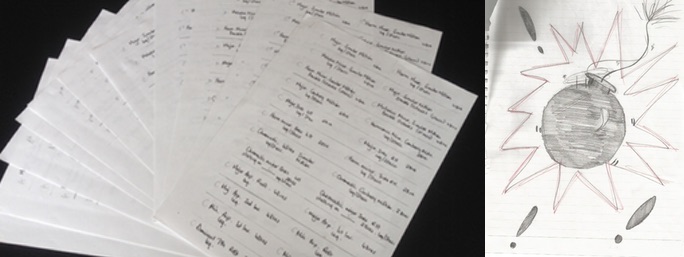Slay a Few Demons!

ABRSM piano scales make for effective therapy. Now, I’m not suggesting that I’m ever in a bad mood… but, hypothetically speaking if I was, it’s better to take it out on the piano. There’s nothing quite like bashing up and down four octaves of the keyboard to vent your spleen and ABRSM of the old school provided plenty of material to go at.
Initially learning the scales is quite a task but once you’ve got them under your fingers theres a sort of “stream of consciousness” mental calm as you rattle up and down. It’s physically tiring and mentally numbing. Additionally, the repetitious quality enhances the calming effect. Listening to the tonal progressions adds to the whole undertaking and the general effect is truly therapeutic. Because you are entirely absorbed in the physical, mental and musical process of the repetitious exercises the poison of your mood gradually ebbs away as you fuel other fires outside of your grumpy temper. You create your own personal therapy bubble and only need emerge when you are ready to face the world again. The extra bonus to all of this is that you’ve actually made really good use of your time as you slay your own demons and so you get a positive outcome rather than achieving a neutral truce.
My family are quite used to the signs. Although I often give a verbal warning to beware of the blast zone they can perceive that extra zealous energy in scales practise which flags up the expediency of keeping out of the way until the tone calms and the fortissimo and tempo abate.
Sadly the syllabus is much diminished in latter years and the scales requirements for the upper piano exams is much reduced - although current pupils still groan and think its a huge work load. When I took my grade 8 (here we go - ‘Back in my day …’ ) each scale group had twenty four permutations (x 2 for staccato/legato and also hands separately then together) and this then had to be replicated twelve times across each semitone of the octave. For example the scale group for the key C would be:
Scale of C major similar motion 4 8ves legato
Scale of C major similar motion 4 8ves staccato
Scale of C harmonic minor similar motion 4 8ves legato
Scale of C harmonic minor similar motion 4 8ves staccato
Scale of C melodic minor similar motion 4 8ves legato
Scale of C melodic minor similar motion 4 8ves staccato
Scale of C major double octaves similar motion 3 8ves staccato
Scale of C harmonic minor double octaves similar motion 3 8ves staccato
Scale of C melodic minor double octaves similar motion 3 8ves staccato
C major contrary motion 2 8ves legato
C major contrary motion 2 8ves staccato
C harmonic minor contrary motion 2 8ves legato
C harmonic minor contrary motion 2 8ves staccato
C major in thirds left hand legato
C major in thirds left hand staccato
C major in thirds right hand legato
C major in thirds right hand staccato
C harmonic minor in thirds left hand legato
C harmonic minor in thirds left hand staccato
C harmonic minor in thirds right hand legato
C harmonic minor in thirds right hand staccato
Chromatic scale on C 4 8ves legato
Chromatic scale on C 4 8ves staccato
Chromatic scale on C in contrary motion 2 8ves legato
Chromatic scale on C in contrary motion 2 8ves staccato
Chromatic minor thirds starting on C 2 8ves left hand legato
Chromatic minor thirds starting on C 2 8ves left hand staccato
Chromatic minor thirds starting on C 2 8ves right hand legato
Chromatic minor thirds starting on C 2 8ves right hand staccato
C major arpeggio in root position 4 8ves legato
C major arpeggio in root position 4 8ves staccato
C major arpeggio in first inversion 4 8ves legato
C major arpeggio in first inversion 4 8ves staccato
C major arpeggio in second inversion 4 8ves legato
C major arpeggio in second inversion 4 8ves staccato
C minor arpeggio in root position 4 8ves legato
C minor arpeggio in root position 4 8ves staccato
C minor arpeggio in first inversion 4 8ves legato
C minor arpeggio in first inversion 4 8ves staccato
C minor arpeggio in second inversion 4 8ves legato
C minor arpeggio in second nversion 4 8ves staccato
Dominant 7th arpeggio of C 4 8ves legato
Dominant 7th arpeggio of C 4 8ves staccato
Diminished 7th arpeggio of C 4 8ves legato
Diminished 7th arpeggio of C 4 8ves staccato
Now work this pattern up the remaining 11 semitones of the octave - you’ll be too tired to feel angry or upset for long!